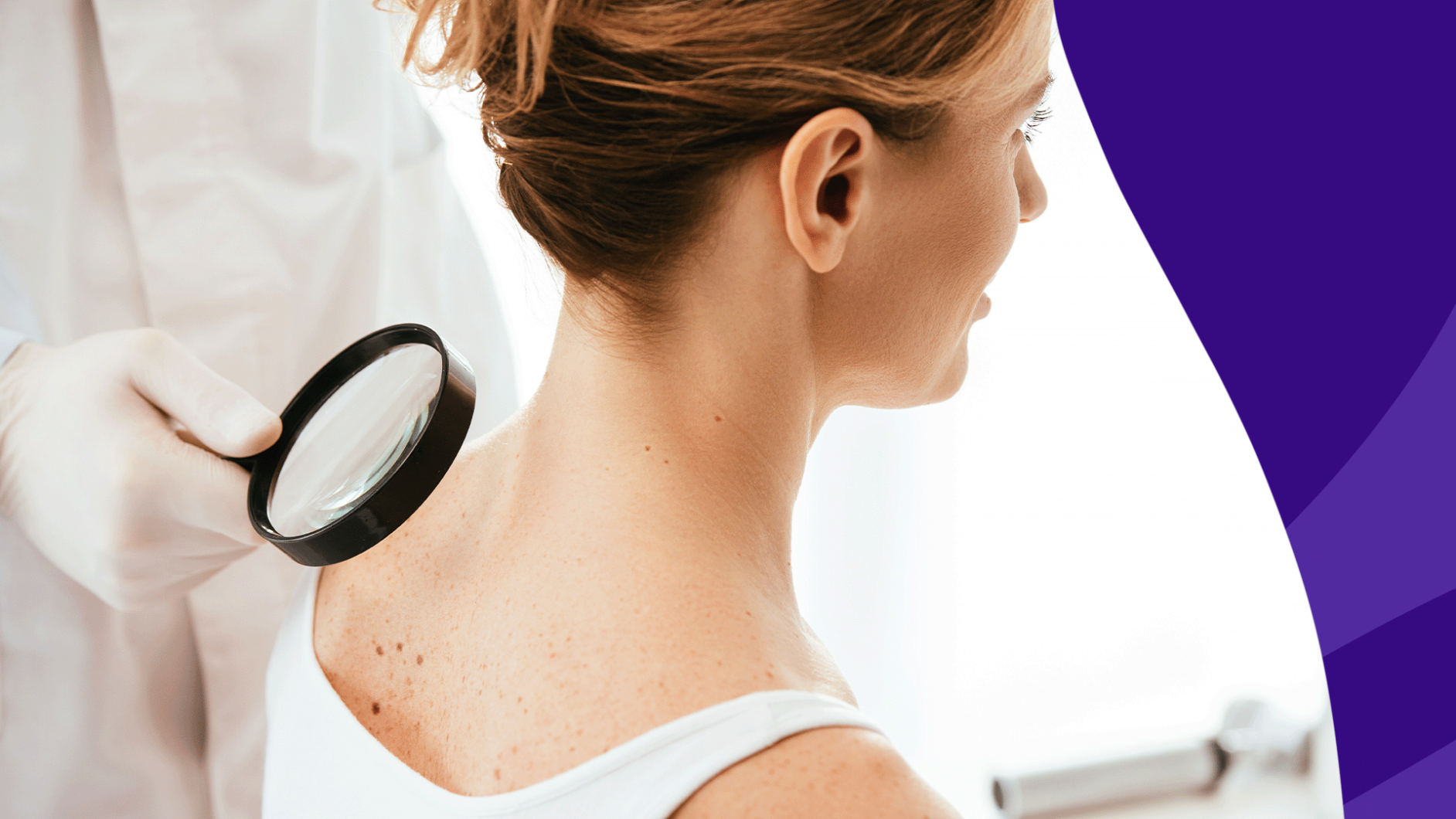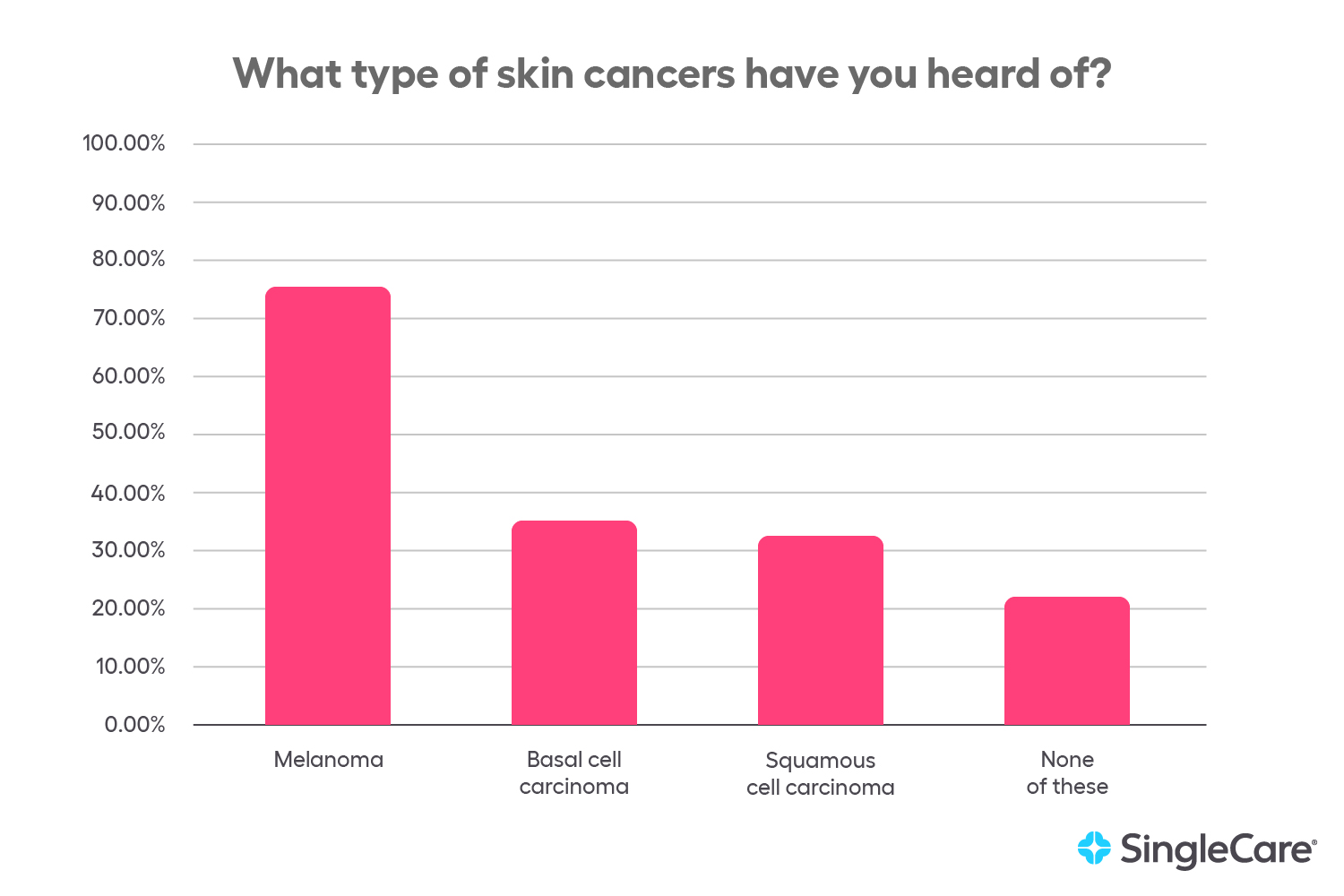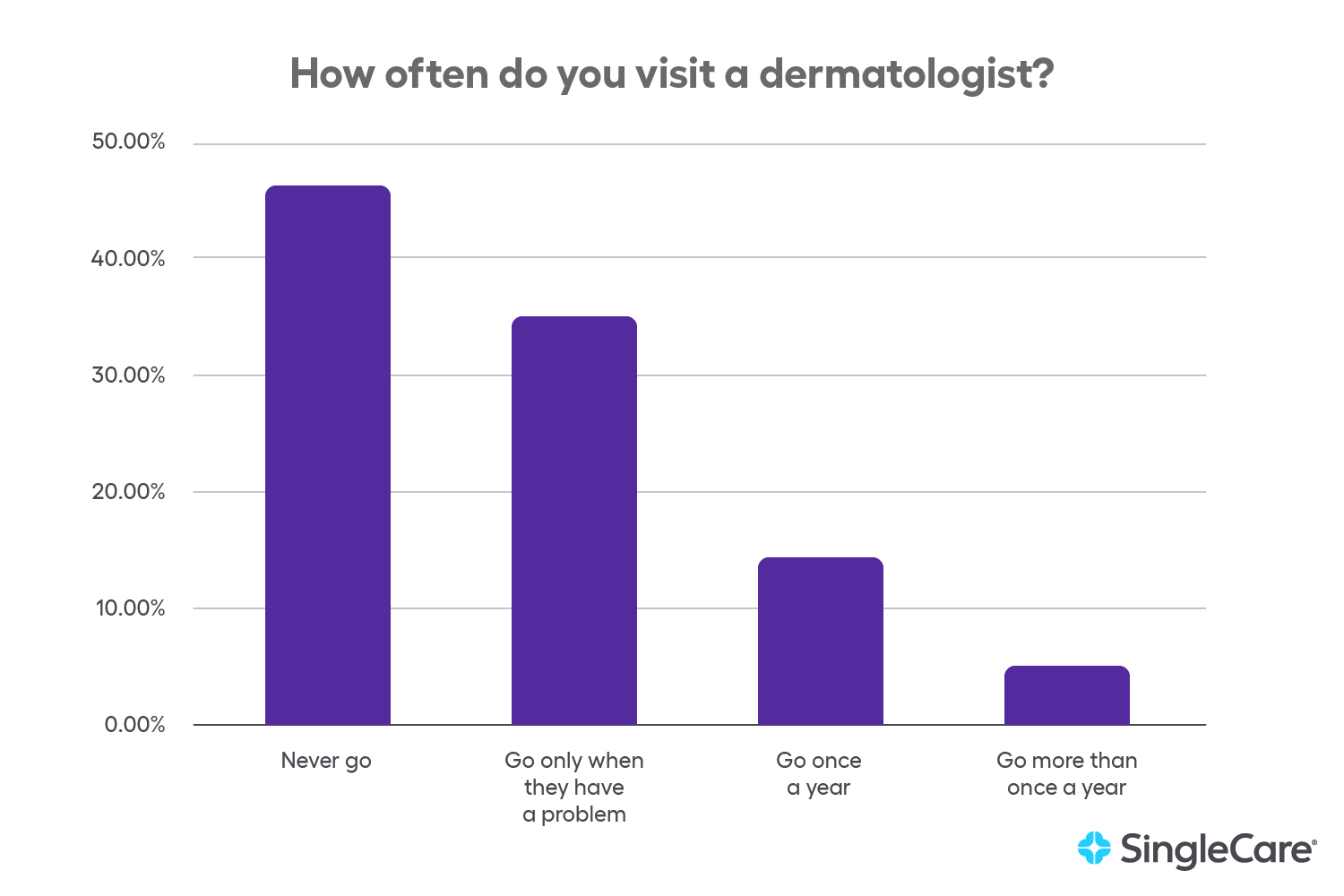While not the most talked about kind of cancer, skin cancer is one of the most common. According to the American Cancer Society, melanoma accounts for only 1% of skin cancers but are the most life-threatening. Of the 99,780 Americans likely to have received a melanoma diagnosis this year, 7,650 are likely to die from it.
Despite medical treatments helping to drop the mortality rate between 2015 and 2019, there’s work to be done in educating the general population about what causes skin cancer and why early detection matters.
Our latest survey about skin cancer looks at attitudes surrounding skin cancer and awareness among different demographic groups. It offers insight into the need for skin cancer education and steps to reduce your risks.
RELATED: Skin cancer statistics
Key findings
Here are the more notable findings from our survey of 1,300 adults aged 18 and older, with a range of educational, ethnic, relationship, and income statuses.
- Nearly a third (29%) of respondents are not concerned about sun-related skin problems.
- Melanoma is the most known type of skin cancer.
- A quarter of people are reportedly unaware of skin cancer risk factors.
- 73% believe everyone should use sunscreen.
- Only 61% use sunscreen as a method of protection from the sun.
- Less than half (46%) know the minimum recommended level of SPF is 30.
- 15% mistakenly believe a sunscreen with a higher SPF lasts longer than one with a lower SPF.
- 69% use sunscreen when outside.
- Nearly half (46%) have never seen a dermatologist.
- 1 in 5 treat sunburn with an aloe vera product with a pain reliever, which is not recommended.
Nearly a third of people are not concerned about sun-related skin problems
Skin cancer is just one reason to keep an eye on sun exposure, but it’s not the only thing to think about. When asked whether they were concerned about sunburn, photoaging (wrinkles or leathery skin), precancerous skin conditions, or skin cancer, 29% of those surveyed said they weren’t concerned about any of these things.
Males and females were almost equally concerned about individual sun-related skin problems, with the exception of photoaging. When it came to wrinkles, leathery skin or rough skin texture, irregular pigmentation, lentigines or large freckle-like spots, 26% of females were concerned, compared to just 12% of males.
Which sun-related skin problem are you most concerned about? |
||
|---|---|---|
| Female | Male | |
| Sunburn | 17% | 20% |
| Photoaging (wrinkles, leathery or rough skin texture, irregular pigmentation, lentigines or large freckle-like spots) | 26% | 12% |
| Actinic keratoses (precancerous growths) | 3% | 3% |
| Skin cancer | 27% | 33% |
| I am not concerned about sun-related skin problems | 26% | 32% |
- 30% are most concerned about skin cancer
- 29% are not concerned about sun-related skin problems
- 20% are most concerned about photoaging (wrinkles, leathery or rough skin texture, irregular pigmentation, lentigines or large freckle-like spots)
- 18% are most concerned about sunburn
- 3% are most concerned about actinic keratoses (precancerous growths)
30% are most concerned about skin cancer
Those who were concerned about sun exposure did mention cancer. 30% were concerned about the condition, almost as many as those who didn’t have any concerns at all.
Melanoma is the most known type of skin cancer
As we mentioned earlier, melanomas aren’t the most common cancers, accounting for just 1% of skin cancer diagnoses. However, it is the most dangerous, which may be why 75% of people surveyed had heard of it. This was more than twice as many people that had heard of basal cell carcinoma (35%) and squamous cell carcinoma (32%.)
More than one-fifth of the respondents (23%) hadn’t heard of any of the cancers mentioned in the survey.
- 75% have heard of melanomas
- 35% have heard about basal cell carcinoma
- 32% have heard of squamous cell carcinoma
- 23% have heard of none of those listed
A quarter of people are reportedly unaware of skin cancer risk factors
Skin cancer can happen to anyone, but some people may be more likely to get the disease than others. When asked about the risk factors associated with cancer, the respondents associated certain skin types with a higher likelihood of skin cancer. Those with freckles or skin that burns and reddens were mentioned by more than 55% of the respondents. Another skin type (lighter natural skin color) was considered a risk factor by 43%.
The second most well-known risk factor is a family history of skin cancer, with 54% of those surveyed mentioning it.
We asked survey respondents about which risk factors outlined by the Centers for Disease Control and Prevention (CDC) they are aware of. Almost 25% of respondents reported that they were unaware of any of the listed risk factors below:
- 55% reported skin that burns, freckles, reddens easily, or becomes painful in the sun as a known risk factor
- 54% reported a family history of skin cancer as a known risk factor
- 43% reported having a lighter natural skin color as a known risk factor
- 39% reported having a personal history of skin cancer as a known risk factor
- 29% reported having blonde or red hair as a known risk factor
- 23% reported having blue or green eyes as a known risk factor
- 22% reported having more than 50 moles as a known risk factor
73% believe everyone should use sunscreen
When it comes to sunscreen, people have firm opinions. 73% felt everyone should use it to protect from the sun, with women slightly more likely to recommend sunscreen than men. This sentiment was consistent across all ethnicities, with 60%-80% of each group insisting that sunscreen be used to protect against sun damage.
| Ethnicity | Yes, everyone should use sunscreen |
| White American | 77% |
| Asian-American | 74% |
| Hispanic/Latino-American | 71% |
| African-American | 62% |
| Multi-racial | 62% |
| Native American | 50% |
| Other | 80% |
- 73% believe everyone should use sunscreen
- 44% believe no sunscreen can block 100% of the sun’s UVB rays
- 43% believe sunscreen should be applied every two hours
- 41% believe UV rays from the sun are reflected by snow, water, and sand
- 26% believe having had a severe childhood sunburn is a risk factor for developing melanoma later in life
- 12% believe sunscreen is not recommended for children younger than 6 months old
- 11% believe none of the above are true
- 9% believe using sunscreen limits the amount of vitamin D you’ll get
- 8% believe sunscreen cannot be waterproof or sweatproof
- 7% believe tanning is safe as long as you don’t burn
- 7% believe you cannot get sunburned on a cloudy day
- 6% believe having a base tan will prevent sunburn
- 4% believe tanning does not cause skin cancer
- 3% believe you do not need to apply sunscreen after 4 p.m.
- 3% believe sunscreen does not expire
RELATED: Does sunscreen expire?
Almost 43% think sunscreen should be applied every two hours
How often you reapply sunscreen depends on many factors, such as the type of sunscreen, the amount of direct sunlight you get, whether you are in the water, and if you sweat a lot. However, the American Academy of Dermatology recommends reapplying sunscreen at least every two hours or after swimming or sweating. Despite the official recommendation, just 43% of people admit to reapplying every two hours. Women were slightly more likely to reapply frequently than men.
Only 61% use sunscreen as a method of protection from the sun
Despite a larger majority stating that everyone should practice sunscreen use, 72% of people who believe that everyone should use sunscreen to protect their skin also reportedly apply sunscreen. White/Caucasians, were more than 60% likely to use sunscreen themselves, while only 40% of those Black/African Americans surveyed said they use sunscreen. Between the genders, 60% of those applying sunscreen were female, and 40% were male.
When asked how they protect themselves from the sun:
- 61% apply sunscreen
- 60% seek shade as often as possible
- 32% wear sun-protective clothing
- 25% reapply sunscreen every 2 hours or after swimming or sweating
- 38% avoid tanning (indoors and outdoors)
- 13% do none of the above
Less than half (46%) know the minimum recommended level of SPF is 30
How much do people know about SPF? Sun protection factor (SPF) measures the solar energy needed for sunburn-protected skin compared to unprotected skin. More SPF means more UV radiation would be needed to burn skin, and a higher SPF is desirable.
According to the Food and Drug Administration (FDA), one popular misconception surrounding SPF relates to the time of solar exposure. SPF relates to the amount of exposure, not the number of minutes or hours in the sun, and can be affected by the time of day, geographic location, and shade.
Among those surveyed, 46% believe SPF 30 is the minimum recommended level for adults and children six months or older.
SPF 30 means it would take you 30 times longer to sunburn than if you weren’t wearing sunscreen at all. 84% reportedly do not believe this.
The misunderstandings regarding SPF were well-documented in this survey, but 84% of those surveyed didn’t agree with the statement, “SPF 30 means it would take you 30 times longer to sunburn than if you weren’t wearing sunscreen.” SPF relates to the level of protection and is not measured in time, but a majority didn’t hold this belief.
15% mistakenly believe a sunscreen with a higher SPF lasts longer than one with a lower SPF.
Again, SPF determines the level of protection, and a small number of those surveyed (15%) think that a higher SPF will allow someone to stay in the sun longer. However, more were familiar with the terms of broad-spectrum and water resistance in sunscreen products. 41% think water resistance is a component of products recommended by the American Academy of Dermatology Association, and 40% thought the same of broad-spectrum products—both of which are true.
Here is how the respondents answered across all groups:
- 46% believe SPF 30 is the minimum recommended level of SPF for adults and children 6 months and older
- 39% believe certain health conditions may require a higher SPF
- 21% believe altitude and distance to the equator affect the level of SPF you need
- 17% believe SPF 100 offers double the UVB protection of SPF 50
- 16% believe SPF 30 means it would take you 30 times longer to sunburn than if you weren’t wearing sunscreen
- 15% believe a sunscreen with higher SPF lasts longer than one with a lower SPF
- 6% believe you don’t have to apply sunscreen with a higher SPF as often as one with a lower SPF
- 20% believe none of these things
69% use sunscreen when outside
Remember the 73% of people who thought everyone should wear sunscreen? A slightly lower number actually use it personally when they are outdoors. 32% rely on protective clothing to get the job done, and 60% seek shade whenever possible.
27% apply sunscreen when outside for long periods of time
About 27% of respondents don’t wear sunscreen for brief outings and only wear it when they are outside for an extended period; 23% only wear it when doing sun activities like going to the beach or swimming. When added to the number of people who wear it whenever they are outside (19%), you get the 69% of participants who are protected when they go out of doors.
In addition, respondents shared the following about their sunscreen habits:
- 27% wear sunscreen only when outside for long periods of time
- 23% wear sunscreen only when outside doing sun-related activities (beach, pool, etc.)
- 21% never wear sunscreen
- 19% wear sunscreen when outside
- 10% wear sunscreen every day
Nearly half have never seen a dermatologist
While a dermatologist plays an important role in an overall patient health plan, 46% have never actually been to one. Of those that have, 14% make it an annual practice, and a few (5%) go even more often than that. Those in the 18-24 age group were the least likely to have seen a dermatologist, with 57% never having seen a dermatologist.
Respondents answered the following about how often they see a dermatologist:
- 46% never see a dermatologist
- 36% only see one when they have a skin problem or concern
- 14% see one yearly
- 5% see one more than once per year
Only 35% see a dermatologist when they have a skin problem or concern
Waiting to see a doctor when there’s a concern is still better than not going at all, and 35% have put off preventative care in lieu of going about a specific problem, such as a skin lesion or mole. Of this group, it was fairly consistent across the age categories, but income may play a role. Those making less than $25,000 a year were significantly less likely to see a doctor about a concern (27% compared to 33%-42% of those in other income groups.) The average cost of a dermatology visit without insurance is $230, but this doesn’t count common procedures that may be performed during the visit, such as removing skin tags or freezing a problem spot (cryotherapy of seborrheic keratoses).
1 in 5 treat sunburn with an aloe vera product with a pain reliever, which is not recommended
When sunburns occur, respondents seemed okay taking matters into their own hands. While 26% do nothing when they get a burn, 46% turn to aloe vera as a treatment, 19% choose an aloe vera product with a pain reliever, and 9% use other products. However, it’s not recommended to use aloe vera with a pain-relieving ingredient ending in “-caine,” such as lidocaine or benzocaine.
Survey respondents shared what they use when treating a sunburn, with
- 46% using aloe vera
- 26% not using anything
- 19% using aloe vera with a pain reliever ending in “-caine”, such as lidocaine or benzocaine
- 9% using other products
RELATED: Home remedies for sunburn relief
How behaviors around skin health vary by ethnicity
The statistics revealed very little about differences between ethnic groups except in a few areas, including the use of sunscreen, tanning, and seeing a dermatologist. These trends show opportunities for everyone to learn more about the risks of skin cancer, including a dermatologist’s role in supporting skin health.
| % that uses sunscreen | % that avoids tanning | % that never sees a dermatologist | |
| African-American | 40% | 25% | 54% |
| Asian-American | 67% | 35% | 45% |
| Hispanic/Latino-American | 66% | 36% | 44% |
| White American | 65% | 41% | 44% |
| Multi-racial | 47% | 44% | 56% |
Our methodology
SingleCare conducted this skin cancer survey online through AYTM on June 2, 2022. This survey includes 1,300 U.S. adults ages 18+. Age and gender were census-balanced to match the U.S. population in age, gender, and U.S. region.














